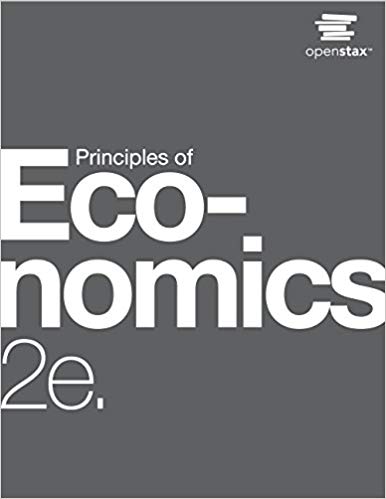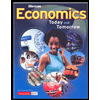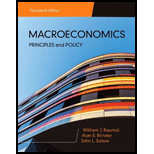
Principles of Economics 2e
2nd Edition
ISBN: 9781947172364
Author: Steven A. Greenlaw; David Shapiro
Publisher: OpenStax
expand_more
expand_more
format_list_bulleted
Textbook Question
Chapter 34, Problem 29RQ
What is the “race to the bottom” scenario?
Expert Solution & Answer
Want to see the full answer?
Check out a sample textbook solution
Students have asked these similar questions
Should Maureen question the family about the history of the home? Can Maureen access public records for proof of repairs?
3. Distinguish between a direct democracy and a representative democracy. Use appropriate
examples to support your answers.
[4]
4. Explain the distinction between outputs and outcomes in social service delivery [2]
5. A R1000 tax payable by all adults could be viewed as both a proportional tax and a
regressive tax. Do you agree? Explain.
[4]
6. Briefly explain the displacement effect in Peacock and Wiseman's model of government
expenditure growth and provide a relevant example of it in the South African context. [5]
7. Explain how unbalanced productivity growth may affect government expenditure and
briefly comment on its relevance to South Africa.
[5]
8. South Africa has recently proposed an increase in its value-added tax rate to 15%, sparking
much controversy. Why is it argued that value-added tax is inequitable and what can be
done to correct the inequity?
[5]
9. Briefly explain the difference between access to education and the quality of education,
and why we should care about the…
20. Factors 01 pro
B. the technological innovations available to companies.
A. the laws that regulate manufacturers.
C. the resources used to create output
D. the waste left over after goods are produced.
21. Table 1.1 shows the tradeoff between different combinations of missile production and home
construction, ceteris paribus. Complete the table by calculating the required opportunity costs for both
missiles and houses. Then answer the indicated question(s).
Combination
Number of
houses
Opportunity cost
of houses in
Number of
missiles
terms of missiles
J
0
4
K
10,000
3
L
17,000
2
1
M
21,000
0
N
23,000
Opportunity cost
of missiles in
terms of houses
Tutorials-Principles of Economics
m health care
Chapter 34 Solutions
Principles of Economics 2e
Ch. 34 - Explain how a tariff reduction causes an Increase...Ch. 34 - Explain how a subsidy on agricultural goods like...Ch. 34 - Explain how trade barriers save jobs in protected...Ch. 34 - Explain how trade barriers raise wages in...Ch. 34 - How does international trade affect working...Ch. 34 - Do the jobs for workers in low-income countries...Ch. 34 - How do trade barriers affect the average Income...Ch. 34 - How does the cost of saving jobs in protected...Ch. 34 - Explain how predatory pricing could be a...Ch. 34 - Why do low-income countries like Brazil, Egypt, or...
Ch. 34 - Explain the logic behind the race to the bottom...Ch. 34 - What are the conditions under which a country may...Ch. 34 - Why is the national security argument not...Ch. 34 - Assume a perfectly competitive market and the...Ch. 34 - What is the difference between a free trade...Ch. 34 - Why would countries promote protectionist laws,...Ch. 34 - What might account for the dramatic increase in...Ch. 34 - How does competition, whether domestic or foreign,...Ch. 34 - What are the gains from competition?Ch. 34 - Who does protectionism protect? From what does it...Ch. 34 - Name and define three policy tools for enacting...Ch. 34 - How does protectionism affect the price of the...Ch. 34 - Does international trade, taken as a whole,...Ch. 34 - Is international trade likely to have roughly the...Ch. 34 - How is international trade, taken as a whole,...Ch. 34 - Is international trade likely to have about the...Ch. 34 - What are main reasons for protecting infant...Ch. 34 - What is dumping? Why does prohibiting it often...Ch. 34 - What is the race to the bottom scenario?Ch. 34 - Do the rules of international trade require that...Ch. 34 - What is the national interest argument for...Ch. 34 - Name several of the international treaties where...Ch. 34 - What is the general trend of trade barriers over...Ch. 34 - If opening up to free trade would benefit a...Ch. 34 - Who gains and who loses from trade?Ch. 34 - Why is trade a good thing if some people lose?Ch. 34 - What are some ways that governments can help...Ch. 34 - Show graphically that for any tariff, there is an...Ch. 34 - From the Work It Out Effects of Trade Barriers,...Ch. 34 - If trade barriers hurt the average worker in an...Ch. 34 - Why do you think labor standards and working...Ch. 34 - How would direct subsidies to key industries be...Ch. 34 - How can governments identify good candidates for...Ch. 34 - Microeconomic theory argues that it is...Ch. 34 - How do you think Americans would feel if other...Ch. 34 - Is it legitimate to impose higher safety standards...Ch. 34 - Why might the unsafe consumer products argument be...Ch. 34 - Why might a tax on domestic consumption of...Ch. 34 - Why do you think that the GAIT rounds and, more...Ch. 34 - An economic union requires giving up some...Ch. 34 - What are some examples of innovative products that...Ch. 34 - In principle, the benefits of international trade...Ch. 34 - Economists sometimes say that protectionism is the...Ch. 34 - Trade has income distribution effects. For...Ch. 34 - Assume two countries, Thailand (T) and Japan (J),...Ch. 34 - You have just been put in charge of trade policy...Ch. 34 - The country of Pepperland exports steel to the...
Additional Business Textbook Solutions
Find more solutions based on key concepts
E6-14 Using accounting vocabulary
Learning Objective 1, 2
Match the accounting terms with the corresponding d...
Horngren's Accounting (12th Edition)
Discussion Questions 1. What characteristics of the product or manufacturing process would lead a company to us...
Managerial Accounting (5th Edition)
Define cost pool, cost tracing, cost allocation, and cost-allocation base.
Horngren's Cost Accounting: A Managerial Emphasis (16th Edition)
A company has the opportunity to take over a redevelopment project in an industrial area of a city. No immediat...
Engineering Economy (17th Edition)
Knowledge Booster
Similar questions
- In a small open economy with a floating exchange rate, the supply of real money balances is fixed and a rise in government spending ______ Group of answer choices Raises the interest rate so that net exports must fall to maintain equilibrium in the goods market. Cannot change the interest rate so that net exports must fall to maintain equilibrium in the goods market. Cannot change the interest rate so income must rise to maintain equilibrium in the money market Raises the interest rate, so that income must rise to maintain equilibrium in the money market.arrow_forwardSuppose a country with a fixed exchange rate decides to implement a devaluation of its currency and commits to maintaining the new fixed parity. This implies (A) ______________ in the demand for its goods and a monetary (B) _______________. Group of answer choices (A) expansion ; (B) contraction (A) contraction ; (B) expansion (A) expansion ; (B) expansion (A) contraction ; (B) contractionarrow_forwardAssume a small open country under fixed exchanges rate and full capital mobility. Prices are fixed in the short run and equilibrium is given initially at point A. An exogenous increase in public spending shifts the IS curve to IS'. Which of the following statements is true? Group of answer choices A new equilibrium is reached at point B. The TR curve will shift down until it passes through point B. A new equilibrium is reached at point C. Point B can only be reached in the absence of capital mobility.arrow_forward
- A decrease in money demand causes the real interest rate to _____ and output to _____ in the short run, before prices adjust to restore equilibrium. Group of answer choices rise; rise fall; fall fall; rise rise; fallarrow_forwardIf a country's policy makers were to continously use expansionary monetary policy in an attempt to hold unemployment below the natural rate , the long urn result would be? Group of answer choices a decrease in the unemployment rate an increase in the level of output All of these an increase in the rate of inflationarrow_forwardA shift in the Aggregate Supply curve to the right will result in a move to a point that is southwest of where the economy is currently at. Group of answer choices True Falsearrow_forward
- An oil shock can cause stagflation, a period of higher inflation and higher unemployment. When this happens, the economy moves to a point to the northeast of where it currently is. After the economy has moved to the northeast, the Federal Reserve can reduce that inflation without having to worry about causing more unemployment. Group of answer choices True Falsearrow_forwardThe long-run Phillips Curve is vertical which indicates Group of answer choices that in the long-run, there is no tradeoff between inflation and unemployment. that in the long-run, there is no tradeoff between inflation and the price level. None of these that in the long-run, the economy returns to a 4 percent level of inflation.arrow_forwardSuppose the exchange rate between the British pound and the U.S. dollar is £1 = $2.00. The U.S. government implementsU.S. government implements a contractionary fiscal policya contractionary fiscal policy. Illustrate the impact of this change in the market for pounds. 1.) Using the line drawing tool, draw and label a new demand line. 2.) Using the line drawing tool, draw and label a new supply line. Note: Carefully follow the instructions above and only draw the required objects.arrow_forward
- Just Part D please, this is for environmental economicsarrow_forward3. Consider a single firm that manufactures chemicals and generates pollution through its emissions E. Researchers have estimated the MDF and MAC curves for the emissions to be the following: MDF = 4E and MAC = 125 – E Policymakers have decided to implement an emissions tax to control pollution. They are aware that a constant per-unit tax of $100 is an efficient policy. Yet they are also aware that this policy is not politically feasible because of the large tax burden it places on the firm. As a result, policymakers propose a two- part tax: a per unit tax of $75 for the first 15 units of emissions an increase in the per unit tax to $100 for all further units of emissions With an emissions tax, what is the general condition that determines how much pollution the regulated party will emit? What is the efficient level of emissions given the above MDF and MAC curves? What are the firm's total tax payments under the constant $100 per-unit tax? What is the firm's total cost of compliance…arrow_forward2. Answer the following questions as they relate to a fishery: Why is the maximum sustainable yield not necessarily the optimal sustainable yield? Does the same intuition apply to Nathaniel's decision of when to cut his trees? What condition will hold at the equilibrium level of fishing in an open-access fishery? Use a graph to explain your answer, and show the level of fishing effort. Would this same condition hold if there was only one boat in the fishery? If not, what condition will hold, and why is it different? Use the same graph to show the single boat's level of effort. Suppose you are given authority to solve the open-access problem in the fishery. What is the key problem that you must address with your policy?arrow_forward
arrow_back_ios
SEE MORE QUESTIONS
arrow_forward_ios
Recommended textbooks for you
 Economics Today and Tomorrow, Student EditionEconomicsISBN:9780078747663Author:McGraw-HillPublisher:Glencoe/McGraw-Hill School Pub Co
Economics Today and Tomorrow, Student EditionEconomicsISBN:9780078747663Author:McGraw-HillPublisher:Glencoe/McGraw-Hill School Pub Co Principles of Economics 2eEconomicsISBN:9781947172364Author:Steven A. Greenlaw; David ShapiroPublisher:OpenStax
Principles of Economics 2eEconomicsISBN:9781947172364Author:Steven A. Greenlaw; David ShapiroPublisher:OpenStax




Economics Today and Tomorrow, Student Edition
Economics
ISBN:9780078747663
Author:McGraw-Hill
Publisher:Glencoe/McGraw-Hill School Pub Co

Principles of Economics 2e
Economics
ISBN:9781947172364
Author:Steven A. Greenlaw; David Shapiro
Publisher:OpenStax



